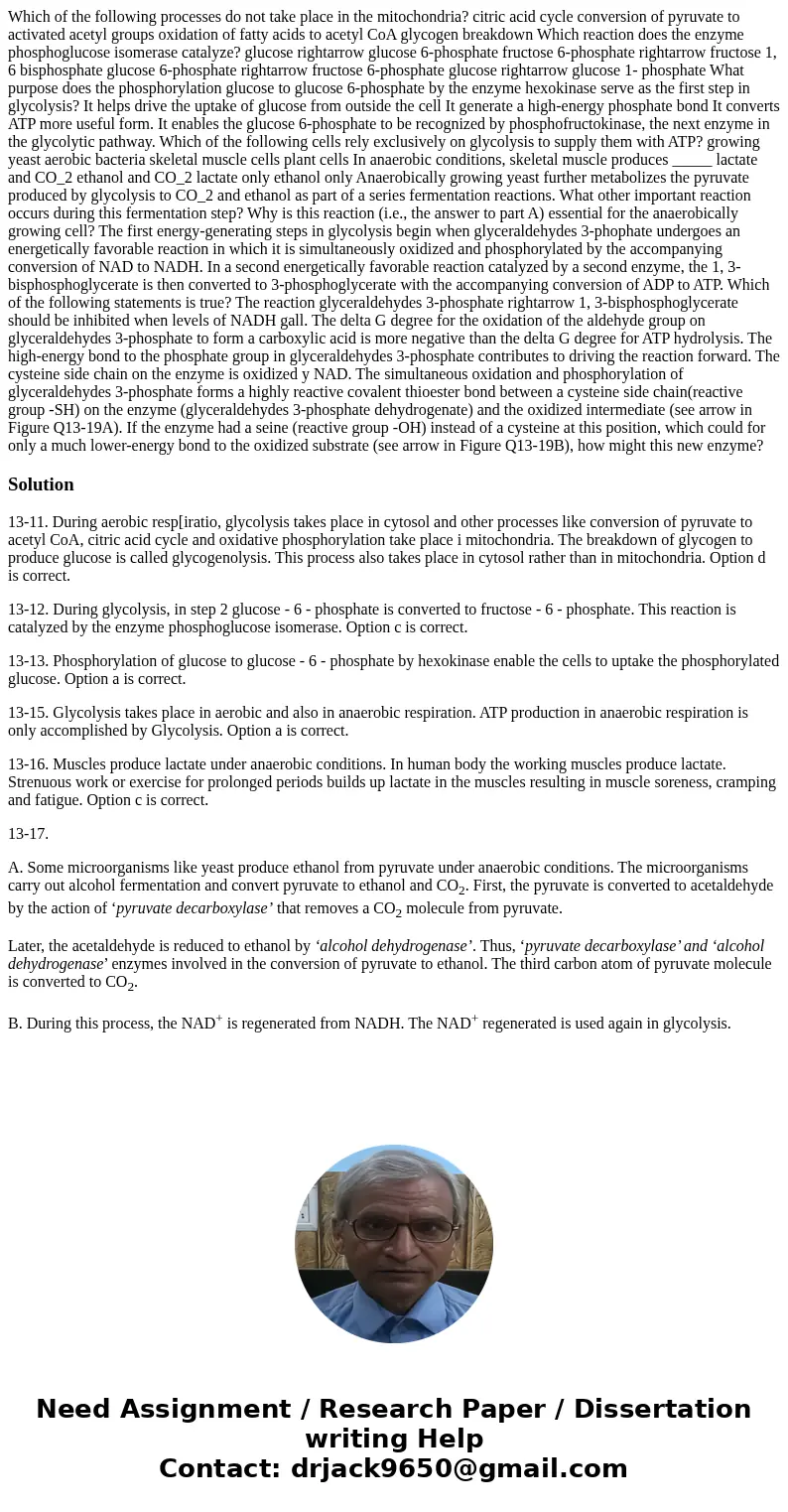Which of the following processes do not take place in the mitochondria? citric acid cycle conversion of pyruvate to activated acetyl groups oxidation of fatty acids to acetyl CoA glycogen breakdown Which reaction does the enzyme phosphoglucose isomerase catalyze? glucose rightarrow glucose 6-phosphate fructose 6-phosphate rightarrow fructose 1, 6 bisphosphate glucose 6-phosphate rightarrow fructose 6-phosphate glucose rightarrow glucose 1- phosphate What purpose does the phosphorylation glucose to glucose 6-phosphate by the enzyme hexokinase serve as the first step in glycolysis? It helps drive the uptake of glucose from outside the cell It generate a high-energy phosphate bond It converts ATP more useful form. It enables the glucose 6-phosphate to be recognized by phosphofructokinase, the next enzyme in the glycolytic pathway. Which of the following cells rely exclusively on glycolysis to supply them with ATP? growing yeast aerobic bacteria skeletal muscle cells plant cells In anaerobic conditions, skeletal muscle produces _____ lactate and CO_2 ethanol and CO_2 lactate only ethanol only Anaerobically growing yeast further metabolizes the pyruvate produced by glycolysis to CO_2 and ethanol as part of a series fermentation reactions. What other important reaction occurs during this fermentation step? Why is this reaction (i.e., the answer to part A) essential for the anaerobically growing cell? The first energy-generating steps in glycolysis begin when glyceraldehydes 3-phophate undergoes an energetically favorable reaction in which it is simultaneously oxidized and phosphorylated by the accompanying conversion of NAD to NADH. In a second energetically favorable reaction catalyzed by a second enzyme, the 1, 3-bisphosphoglycerate is then converted to 3-phosphoglycerate with the accompanying conversion of ADP to ATP. Which of the following statements is true? The reaction glyceraldehydes 3-phosphate rightarrow 1, 3-bisphosphoglycerate should be inhibited when levels of NADH gall. The delta G degree for the oxidation of the aldehyde group on glyceraldehydes 3-phosphate to form a carboxylic acid is more negative than the delta G degree for ATP hydrolysis. The high-energy bond to the phosphate group in glyceraldehydes 3-phosphate contributes to driving the reaction forward. The cysteine side chain on the enzyme is oxidized y NAD. The simultaneous oxidation and phosphorylation of glyceraldehydes 3-phosphate forms a highly reactive covalent thioester bond between a cysteine side chain(reactive group -SH) on the enzyme (glyceraldehydes 3-phosphate dehydrogenate) and the oxidized intermediate (see arrow in Figure Q13-19A). If the enzyme had a seine (reactive group -OH) instead of a cysteine at this position, which could for only a much lower-energy bond to the oxidized substrate (see arrow in Figure Q13-19B), how might this new enzyme?
13-11. During aerobic resp[iratio, glycolysis takes place in cytosol and other processes like conversion of pyruvate to acetyl CoA, citric acid cycle and oxidative phosphorylation take place i mitochondria. The breakdown of glycogen to produce glucose is called glycogenolysis. This process also takes place in cytosol rather than in mitochondria. Option d is correct.
13-12. During glycolysis, in step 2 glucose - 6 - phosphate is converted to fructose - 6 - phosphate. This reaction is catalyzed by the enzyme phosphoglucose isomerase. Option c is correct.
13-13. Phosphorylation of glucose to glucose - 6 - phosphate by hexokinase enable the cells to uptake the phosphorylated glucose. Option a is correct.
13-15. Glycolysis takes place in aerobic and also in anaerobic respiration. ATP production in anaerobic respiration is only accomplished by Glycolysis. Option a is correct.
13-16. Muscles produce lactate under anaerobic conditions. In human body the working muscles produce lactate. Strenuous work or exercise for prolonged periods builds up lactate in the muscles resulting in muscle soreness, cramping and fatigue. Option c is correct.
13-17.
A. Some microorganisms like yeast produce ethanol from pyruvate under anaerobic conditions. The microorganisms carry out alcohol fermentation and convert pyruvate to ethanol and CO2. First, the pyruvate is converted to acetaldehyde by the action of ‘pyruvate decarboxylase’ that removes a CO2 molecule from pyruvate.
Later, the acetaldehyde is reduced to ethanol by ‘alcohol dehydrogenase’. Thus, ‘pyruvate decarboxylase’ and ‘alcohol dehydrogenase’ enzymes involved in the conversion of pyruvate to ethanol. The third carbon atom of pyruvate molecule is converted to CO2.
B. During this process, the NAD+ is regenerated from NADH. The NAD+ regenerated is used again in glycolysis.

 Homework Sourse
Homework Sourse